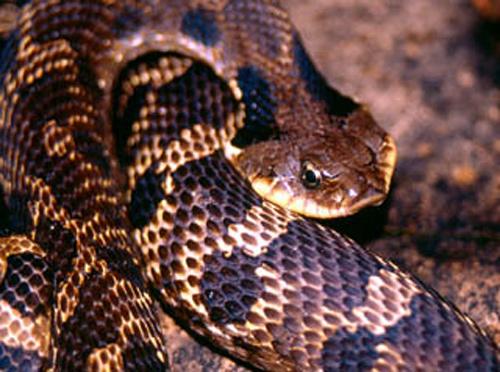The eastern hog-nosed snake is a thick snake. Their coloration can be quite variable. They can have alternating splotches of brown, yellow and reddish orange. Some can be a uniform color of brown, olive green or gray. They have an upturned nose, and have a hood on their head and neck. These snakes can be 21 to 32 inches long.
Eastern hog-nosed snakes range across much of the eastern half of the US except for Vermont, New Hampshire, Maine and much of New York. (there is a western hog-nosed snake that lives in a band in the west-central US). In Connecticut the eastern hog-nosed snake can be found throughout the state. They are most common in the glacial sand and gravel deposits spanning the central potions of the eastern and western hills.
Eastern hog-nosed snakes like sandy and gravely well-drained areas, and can also be found in dry areas adjacent to secondary growth deciduos forests.
Mating season is in April or May in New England. Females will lay eggs in soil or rotting wood in June or July. She does not care for her eggs, they hatch on their own in August.
Eastern hog-nosed snakes hibernate in the winter from about October to April. Unlike most snakes they can dig their own burrows but often use abandoned burrows of other animals for dens. They are active during the day and frequently bask in the sun in the morning and late afternoon. Snakes cannot regulate their body temperature internally and warm themselves in the sun.
Eastern hog-nosed snakes are active hunters and eat mostly toads. They pursue prey, often digging out toads with their snouts, and swallow them whole. Hog-nosed snakes are immune to the toxins produced by the parotid glands of most toads. They are also equipped to deal with the toad defense mechanism of puffing up their bodies with air to become too large to swallow. Hog-nosed snakes have teeth in the back of their jaw placed so they puncture and deflate a puffed-up toad. They may also eat some frogs and salamanders.
Eastern hog-nosed snakes will try to avoid humans. If threatened or cornered they will put on quite a show which is pretty much all bluff. They can expand the hood on their head and neck, which is similar to a cobra's. They will hiss loudly and make striking motions towards the threat, although their mouths are not open for biting. They rarely bite defensively (although it can happen) and are not venomous. Their final line of defense is to play dead. The snake flips over on its back and lets its mouth hang open and its tongue stick out. Part of its mouth lining will close off its throat during this pantomime to keep debris from being swallowed and the snake will often drool. If left alone the hog-nose snake will eventually flip back over and go about its business normally.
The aggressive show often causes the poor, harmless hog-nosed snake to be mistaken for a venomous snake by humans and killed. It is best not to approach or attempt to handle snakes. Even the venomous ones just want to avoid humans. Leave them in peace and they will leave you alone.
The eastern hog-nosed snake is often mistaken for the northern copperhead or timber rattlesnake.
